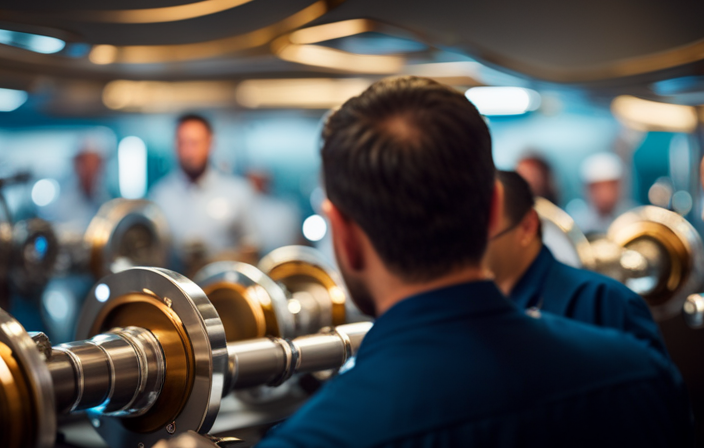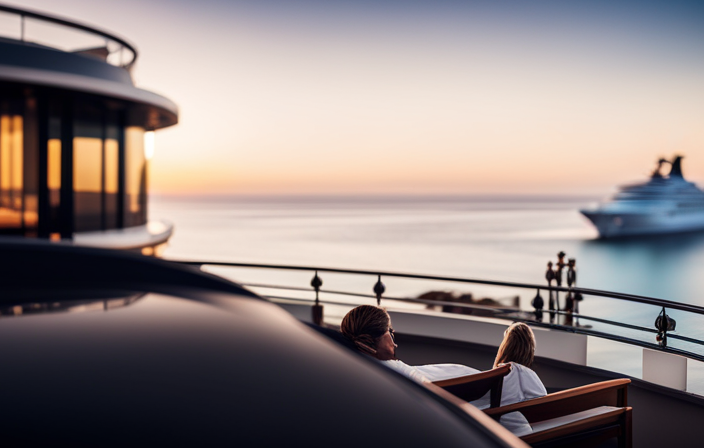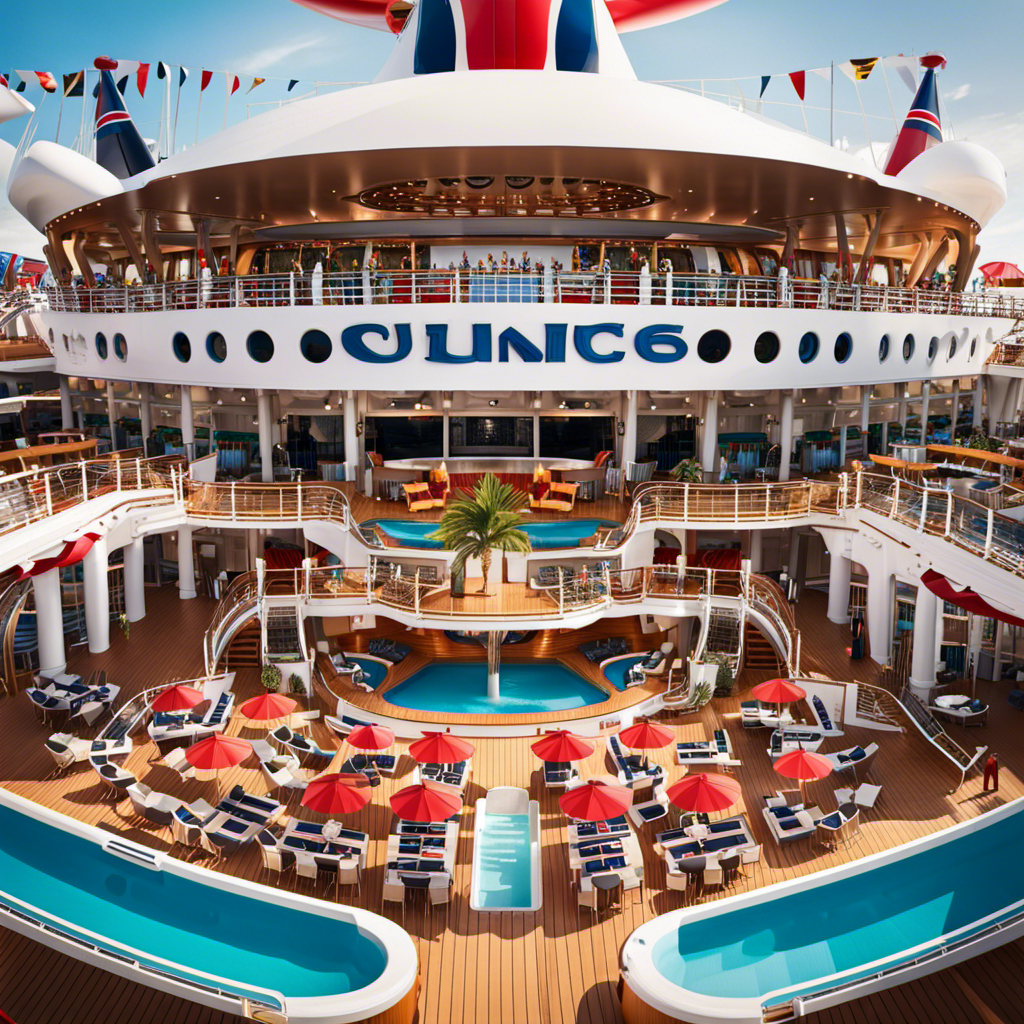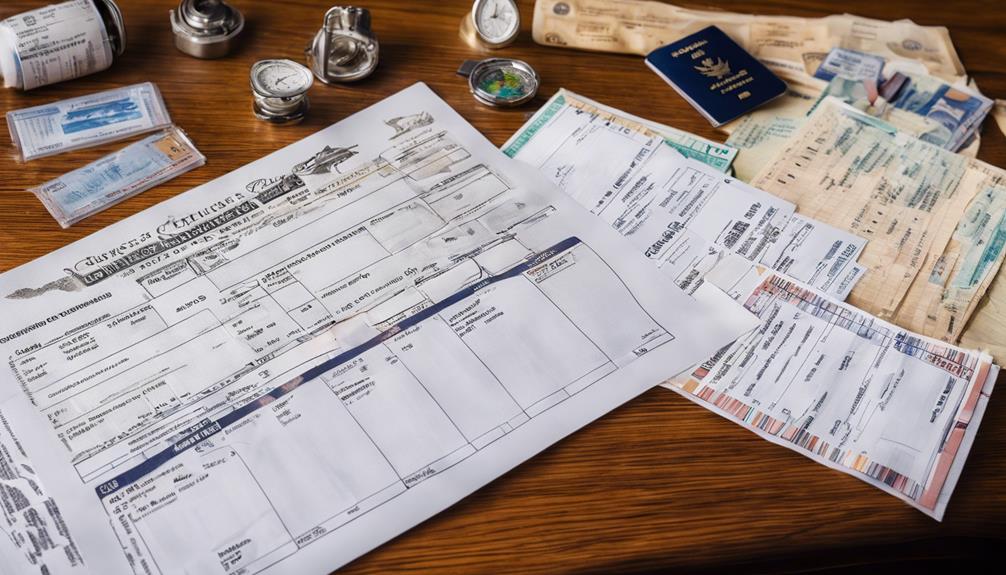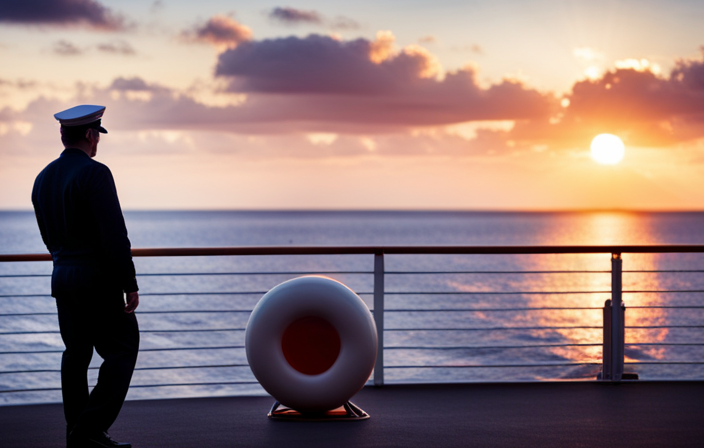You might be thinking, ‘Operating a cruise ship must be an enormously expensive endeavor.’ And you would be right. The costs associated with maintaining a cruise ship are indeed substantial.
From fuel expenses to crew salaries, from maintenance and repairs to port fees and taxes, there are numerous factors that contribute to the overall cost of running a cruise ship.
In this article, we will delve into the intricate details of these expenses, providing you with a comprehensive understanding of just how much it takes to keep a cruise ship afloat.
We will explore the data-driven analysis of fuel costs, the meticulous maintenance and repair requirements, the salaries and benefits provided to the hardworking crew members, the expenses associated with food and beverage provisions, as well as the capital expenditures for upgrades and renovations.
So, if you’ve ever wondered about the financial intricacies behind operating a cruise ship, look no further. Let’s dive in and uncover the true costs of running a cruise ship.
Key Takeaways
- Fuel costs are a significant portion of the expenses and require a tremendous amount of fuel. Improving fuel efficiency is crucial for cost savings and pollution reduction.
- Maintenance and repairs cost millions of dollars each year, including routine upkeep, cleaning, painting, and repairing wear and tear. Dry dock expenses for hull cleaning, propeller repairs, and engine overhauls are also necessary.
- Crew salaries and benefits, including training, turnover rates, attractive benefits, and adequate staffing levels, are essential for running a cruise ship successfully.
- Port fees and taxes vary based on ship size, duration of stay, and location. Additional charges may apply for services such as waste disposal and security.
Fuel Costs
You’ll be surprised by how much it’ll cost you to fuel up a cruise ship. Fuel costs make up a significant portion of the expenses involved in running a cruise ship.
Cruise ships are massive vessels that require a tremendous amount of fuel to power their engines and propel them through the water. The fuel efficiency of a cruise ship is a crucial factor in determining its operating costs. Ships with better fuel efficiency can save significant amounts of money in the long run. Additionally, the environmental impact of cruise ship fuel consumption cannot be ignored. The industry has been under scrutiny for its carbon emissions and efforts are being made to improve fuel efficiency and reduce pollution.
Transitioning from fuel costs, the next major expense in running a cruise ship is maintenance and repairs.
Maintenance and Repairs
Don’t be fooled, maintaining and fixing a floating luxury hotel like a cruise ship can be quite the wallet-draining experience. The costs associated with keeping a cruise ship in top shape are substantial and can easily run into millions of dollars each year. Maintenance costs include routine upkeep, such as cleaning, painting, and repairing wear and tear. Additionally, cruise ships require periodic dry dock expenses, where they are taken out of service for extensive maintenance and repairs. These dry docks can last for several weeks and involve tasks like hull cleaning, propeller repairs, and even engine overhauls. The table below provides an overview of the typical maintenance costs and dry dock expenses for a cruise ship:
| Maintenance Costs | Dry Dock Expenses |
|---|---|
| Cleaning | $500,000 |
| Painting | $1,000,000 |
| Wear and Tear | $2,500,000 |
| Hull Cleaning | $3,000,000 |
| Propeller Repairs | $1,500,000 |
Moving onto crew salaries and benefits, it’s important to consider the significant costs associated with staffing a cruise ship.
Crew Salaries and Benefits
Staffing a cruise ship comes with a hefty price tag as the crew members enjoy competitive salaries and an array of attractive benefits. Here are four key factors that contribute to the cost of crew salaries and benefits:
-
Crew Training: Cruise lines invest significant resources in training their crew members to ensure they have the necessary skills and knowledge to deliver exceptional service. This includes specialized training for various departments such as hospitality, entertainment, and safety.
-
Employee Turnover: High turnover rates among crew members can increase costs due to recruitment, training, and onboard orientation for new hires. Cruise lines strive to minimize turnover by offering competitive salaries and creating a positive work environment.
-
Attractive Benefits: Along with salaries, crew members often receive benefits such as free accommodation, meals, medical insurance, and access to onboard facilities. These perks not only attract qualified individuals but also contribute to their job satisfaction and retention.
-
Staffing Levels: Cruise ships require a large number of crew members to ensure smooth operations and exceptional guest experiences. From housekeeping to food service, various departments need adequate staffing, which adds to the overall cost.
Moving on to the next section about ‘food and beverage expenses,’ it is important to consider the significant role these costs play in running a cruise ship.
Food and Beverage Expenses
The aroma of delectable cuisine permeates the air, enticing guests to indulge in the culinary delights that contribute to the vibrant atmosphere on board a cruise ship. Food and beverage expenses play a significant role in the overall cost of running a cruise ship.
Catering expenses encompass a wide range of costs, including purchasing ingredients, maintaining a well-equipped kitchen, and hiring skilled chefs and kitchen staff. Cruise ships offer a variety of dining options to cater to different tastes and preferences, ranging from buffet-style restaurants to upscale specialty eateries. These options require careful planning and management to ensure quality service and a diverse menu selection.
Understanding and controlling food and beverage costs are essential for cruise ship operators to maintain profitability while providing an exceptional dining experience for their guests.
As we transition into the subsequent section about port fees and taxes, it is crucial to consider all the expenses involved in running a cruise ship.
Port Fees and Taxes
Get ready to dock and prepare your wallet for some hefty port fees and taxes, because exploring new destinations on a cruise comes at a price. Port fees are a significant expense for cruise ship operators. These fees vary depending on the size of the ship, the duration of the stay, and the location of the port.
In addition to the basic fee for using the port facilities, there are often additional charges for services such as waste disposal and security. Furthermore, environmental regulations have led to increased costs for cruise ships. Many ports now require ships to comply with strict emission standards, which can result in additional expenses for retrofitting vessels or using cleaner fuels. These factors contribute to the overall cost of running a cruise ship.
Speaking of expenses, let’s now delve into the next section about insurance and legal expenses, where unforeseen costs and potential risks await.
Insurance and Legal Expenses
Covering the expenses of insurance and legal matters can be a complex endeavor for cruise ship operators, requiring careful planning and financial resources. When it comes to insurance, cruise ship companies face significant risks and potential liabilities. Insurance claims can arise from a variety of incidents, including accidents, medical emergencies, and even natural disasters.
To mitigate these risks, operators must obtain comprehensive liability coverage, which can be quite costly. Additionally, legal expenses can add to the financial burden, especially when dealing with lawsuits, regulatory compliance, and other legal matters. Cruise ship operators need to allocate a substantial portion of their budget to insurance and legal expenses to ensure they are adequately protected and prepared for any unforeseen events.
Transitioning into the subsequent section about marketing and advertising costs, it’s crucial for operators to strike the right balance between financial resources allocated to insurance and legal matters and those dedicated to promoting their services.
Marketing and Advertising Costs
Imagine how your marketing and advertising expenses can skyrocket as you strive to create an irresistible buzz and attract droves of eager vacationers to experience the ultimate getaway on your luxurious floating paradise.
Promotional campaigns and branding strategies are essential to ensure the success of your cruise ship. To build brand awareness and entice potential customers, you need a comprehensive marketing plan that includes online and offline advertising, social media campaigns, print materials, and strategic partnerships.
The costs associated with these efforts can add up quickly, with expenses including advertising space, creative development, media buying, and agency fees. It’s crucial to carefully analyze the return on investment for each marketing initiative, tracking metrics such as website visits, social media engagement, and bookings.
By constantly refining your strategies based on data-driven insights, you can optimize your marketing efforts and maximize your reach.
As we transition to the next section on administrative and office expenses, it’s important to consider the holistic nature of running a cruise ship business.
Administrative and Office Expenses
To effectively manage your luxurious floating paradise, you’ll need to budget for various administrative and office expenses, ensuring smooth operations and providing exceptional service to your guests.
Office supplies play a crucial role in maintaining an efficient workplace on board. From paper and pens to printers and computers, these items are necessary to keep the administrative staff organized and productive.
Additionally, hiring a competent administrative staff is essential for handling the day-to-day operations of the cruise ship. These individuals are responsible for managing bookings, handling customer inquiries, and coordinating with various departments. Investing in a capable and well-trained team ensures that administrative tasks are executed effectively, allowing for seamless operations.
As we transition to the subsequent section about ‘entertainment and activities’, it is important to note that these elements contribute to the overall guest experience.
Entertainment and Activities
Get ready to immerse yourself in a world of excitement and fun as you explore the endless entertainment options and thrilling activities available on board your luxurious floating paradise.
Cruise ships are designed to offer a wide range of entertainment choices to cater to every passenger’s interests and preferences. From Broadway-style shows and live music performances to comedy clubs and casinos, there is something for everyone to enjoy.
Additionally, cruise ships boast a variety of onboard amenities such as swimming pools, water parks, sports facilities, and spas, providing ample opportunities for relaxation and recreation. Whether you prefer a vibrant nightlife with themed parties and clubs or a more laid-back evening with a movie under the stars, cruise ships have it all.
As we delve into the next section on capital expenditures for upgrades and renovations, you’ll discover how cruise lines continually invest in enhancing the onboard experience.
Capital Expenditures for Upgrades and Renovations
With a wave of their magic wand, cruise lines sprinkle their ships with sparkling upgrades and renovations, transforming them into floating palaces fit for royalty. However, these transformations come at a cost. The capital expenditures for upgrades and renovations on cruise ships can be quite substantial.
One major expense is the cost of materials. Cruise lines must purchase high-quality materials to ensure the longevity and safety of the upgrades. This includes everything from premium wood for deck renovations to state-of-the-art equipment for entertainment venues.
Another significant cost is labor. Skilled workers are needed to carry out the upgrades and renovations, and their expertise comes at a price. Whether it’s carpenters, electricians, or interior designers, the wages and benefits add up.
Considering the scale of these projects, it’s no wonder that the cost of upgrading and renovating cruise ships is a significant part of running a successful cruise line.
Frequently Asked Questions
What is the average length of a cruise ship’s journey?
The average duration of a cruise ship’s journey varies depending on the popular destinations. On average, a cruise ship journey lasts for about 7 to 10 days, with some longer voyages lasting up to 14 days or more.
How many passengers can a typical cruise ship accommodate?
A typical cruise ship can accommodate an astounding number of passengers. With an average capacity of thousands, these floating cities offer a luxurious experience for travelers seeking adventure and relaxation on the open seas.
Are there any additional costs for onboard activities and amenities?
Yes, there are additional fees for onboard activities and amenities. Passengers can enjoy a variety of entertainment options such as shows, casinos, and spas, but these come at an extra cost.
How much does it cost to build a new cruise ship?
The cost of building a new cruise ship can vary greatly depending on the size and features. Generally, it can range from hundreds of millions to over a billion dollars, with the construction timeline taking several years to complete.
Do cruise ships generate revenue from sources other than ticket sales?
Cruise ships generate revenue from sponsorship partnerships, onboard shopping and dining, casino activities, and shore excursions. These additional sources of income contribute to the financial success of the industry, beyond just ticket sales.
Conclusion
In conclusion, after thoroughly investigating the costs associated with running a cruise ship, it’s evident that the expenses are substantial and varied.
From fuel costs and maintenance to crew salaries and food expenses, the financial aspect of operating a cruise ship is complex.
Additionally, port fees, marketing expenses, and administrative costs add to the overall expenditure.
Moreover, capital expenditures for upgrades and renovations are necessary to ensure the ship’s competitiveness in the market.
It’s crucial for cruise ship operators to carefully analyze data and make informed decisions to manage these costs effectively.

